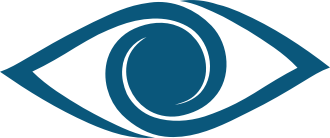The human eye is an incredible natural structure that could be likened to a camera. Vision is created by the eye focusing the light to produce images, as does a camera.
The cornea
The cornea is the clear, outer layer at the front of the eye. The light from the environment enters the cornea, passing through the pupil.
The pupil
The pupil of the eye functions like a camera’s aperture, opening and reducing, depending on the amount of available light. The pupil naturally dilates or constricts, to allow the right amount of light to enter the eye to produce images.
The Iris
The iris is a flat, circular membrane located behind the cornea, which gives the eyes their color.
The Lens
The lens of the eye could be compared to the lens on a camera – a healthy lens focuses the light entering the eye, based on the distance of the object. The lens changes shape, becoming rounder or flatter, to focus the light rays on the retina. The lens adjusts its shape with actions performed by tiny muscles, allowing the eye to focus to rapidly shift to objects near or far.
The Retina
The retina is a very thin layer of tissue at the back of the eye. As the light travels through the lens to the retina, it passes through a substance called “vitreous humor,” a clear substance, gel-like in quality, that fills the eye structure. The retina triggers nerve impulses sent through the optic nerve to the brain, which forms the visual images we call sight.
How Cataracts Develop
The lens is a unique natural structure, made of water and special proteins call “crystallins.” The crystallins appear in a specific pattern that allows the lens to remain transparent, producing clear, crisp vision. With age, these proteins begin to clump together, hindering and distorting the light landing on the retina. In the first stage of cataract development, the changes are minimal and may be unnoticeable. As the condition advances, objects you see can become blurred or distorted, or you develop nearsightedness.
As cataracts become denser, your vision may become even more blurry, with everything in your range of vision taking on a yellowish haze, making driving, reading, or other everyday activities difficult. At some point, altering your eyeglasses prescription is not enough to correct your vision, and you will need to undergo cataract surgery to continue to drive safely or enjoy everyday life with clear vision.


Types of Cataracts
Cataracts are classified into three types, and you may have one or a combination of these types:
- Nuclear sclerotic cataracts: These are common, age-related cataracts that cloud the center (nucleus) of the lens, which eventually develops a yellow, then brown color. As it becomes darker, it hardens, or in medical terms, “sclerosis.”
- Cortical cataracts: This type of cataract appears on the cortex, or outer layer of the lens, appearing as white-colored spokes under the iris, eventually extending into the center of the pupil. These spokes scatter the light entering the eye, causing glare and blurred vision, and may affect depth perception. This type of cataract often develops in people with diabetes, as high blood sugar can damage the lens.
- Posterior subcapsular cataracts: These cataracts form on the back of the lens, beneath the lens capsule that holds the lens in place. This condition leads to vision problems, with haloes appearing around objects. These cataracts develop more quickly, appearing over months, not years. People who are on steroids or have diabetes are at higher risk of developing this type of cataracts.
Cataract surgery at Beverly Hills Institute of Ophthalmology
Beverly Hills Institute of Ophthalmology is recognized as the premier vision correction and eye treatment center in Beverly Hills. Our board-certified eye specialists perform precision cataract surgery and next-generation intraocular lenses.


